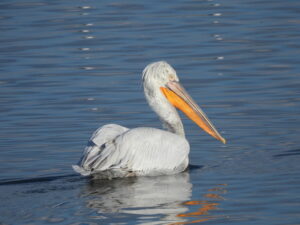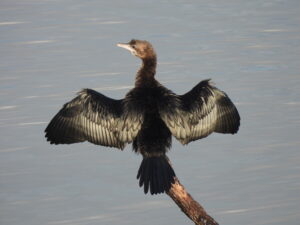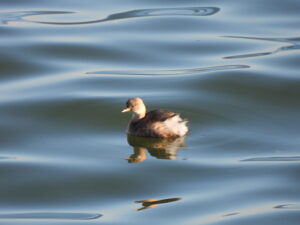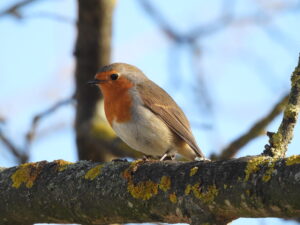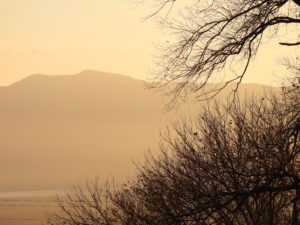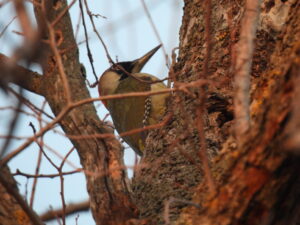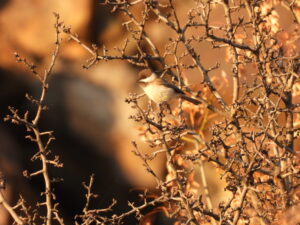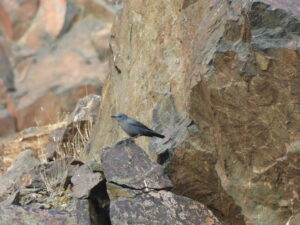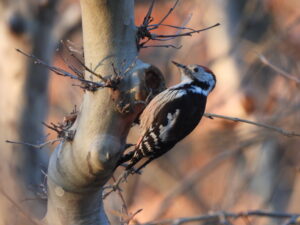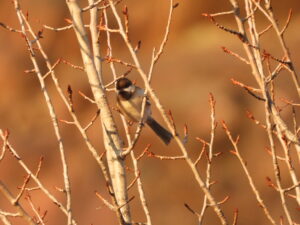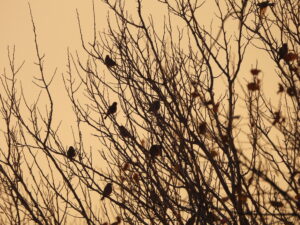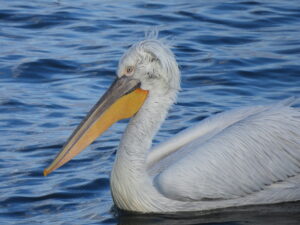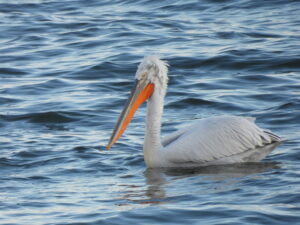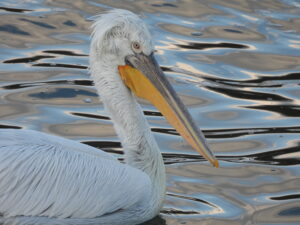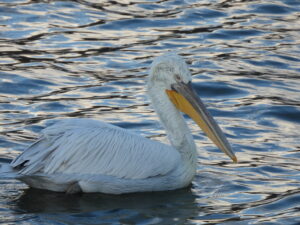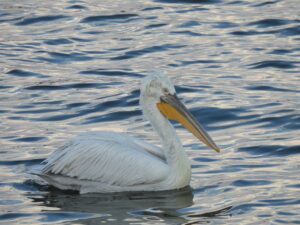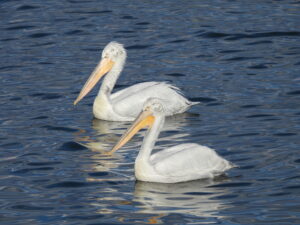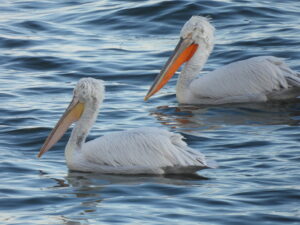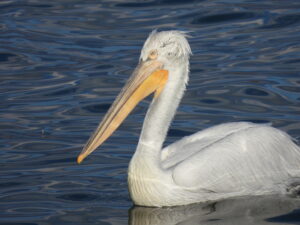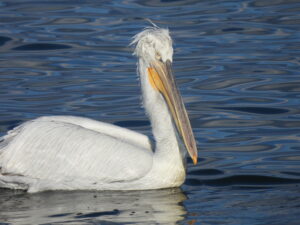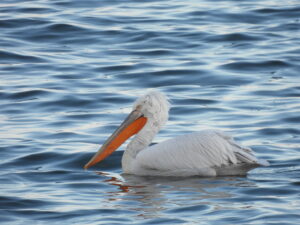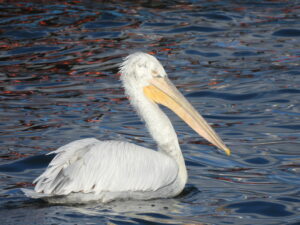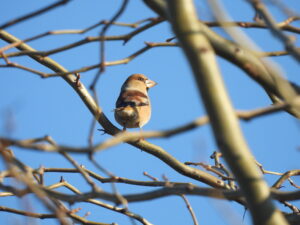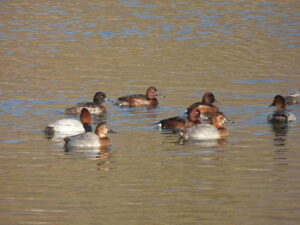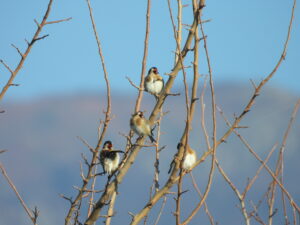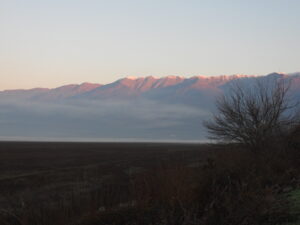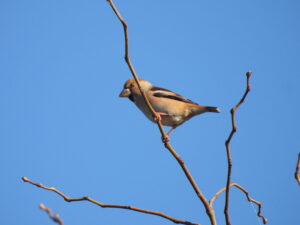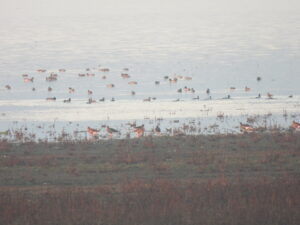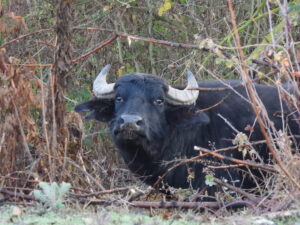Dalmatian pelicans in Lake Kerkini, 11 Dec 2025
Day 1 Wednesday 11th December 2024
We arrived to Sofia airport in Bulgaria just past midnight. A shuttle bus and a van brought us to our rental car in the airport. Because Bulgaria is not a Schengen country yet during our visit, we had to arrange some paperwork to cross the border — although no one asked for anything at the checkpoint.
We left the airport after 02:00 and started driving and sleeping intermittently. While driving, we built a plan for birding in Lake Kerkini, checking out the usual spots to fetch our target species on eBird and the last checklists.
The drive was quite uneventful and there was no traffic on the road overnight. We reached the border at Kulata in Bulgaria during sunrise. Tens of trucks queue in one lane, but the car lane was completely empty. A fast passport check, and about a minute later we had entered Greece.
We approached the surroundings of Lake Kerkini less than an hour later. The sun was very low while we drove across fields. Corn buntings, cirl buntings, song thrushes, common buzzards and green sandpipers were seen on the fields.
We bagged our first target before even reaching our first planned stop: a pair of Syrian woodpeckers creeped on wooden poles and trees nearby. Afterwards, we reached Lithotopos and grabbed some hot drinks in a café by the dam.
Views of Lake Kerkini from the dam, 11 Dec 2024
Lithotopos dam
Water reservoir dam in Lithotopos village that maintains the volume of Lake Kerkini. First built in 1932, its creation established the presence of the whole lake. Now good numbers of gulls, cormorants and pelicans forage in the area in winter (see here).
The dam provided several of our targets. Pygmy cormorants and Dalmatian pelicans were quite abundant. Among the numerous black-headed gulls we identified several yellow-legged gulls, Caspian gulls and whiskered terns. Eurasian coots, mallards, little grebes and great crested grebes. Scoping the lake, we connected with several distant great white pelicans too.
The west side of the dam has a viewpoint giving a good perspective of the south end of Lake Kerkini. From there, we could see an island full of pelicans in the distance. We also noticed a tiny boat with a driver and a couple of photographers, surrounded by tens of Dalmatian pelicans. We have seen fantastic pictures of the pelicans on the internet and wondered if the boats are the only way to approach these birds.
The shore had numerous pygmy cormorants and great cormorants sunbathing, as well as several gray herons, great egrets and little egrets. A white (domestic) Muscovy duck was present as well.
Additional birds in the vegetation included blackbirds, black redstarts, robins, wrens, chiffchaffs, blue tits and great tits. Several magpies and hooded crows flew by, as so did a Eurasian spoonbill just before we left.
Wet plains ahead of Mandraki Port, 11 Dec 2024
Mandraki port
Nice viewpoint at the north embankment of Lake Kerkini close to Akritochori village. The extension of plains between the road and the lake provide good foraging grounds for waders, cranes and geese, while waterfowl swim farther away in the lake (see here).
The next stop gave us panoramic views of Lake Kerkini from the north embankment. As some other future stops, the viewpoint would be from a road surrounded by trees and bushes and a big extension of plains would precede the distant shore.
Flocks of hundreds of greater flamingos and common shelducks foraged on the water. With the scope, we managed to connect with numerous pelicans, shovelers and mallards. On the plains, we see a flock of graylag geese, three common cranes and a curlew. Five pied avocets fly along the shore.
Raptors are numerous, with several western marsh harriers, common buzzards, greater spotted eagles and Eurasian sparrowhawks seen. Flyby hooded crows and Eurasian magpies fly over announced themselves with their calls, as so did meadow pipits and hundreds of goldfinches in big flocks.
Long-tailed tit (Aegithalos caudatus) in the shrubs, 11 Dec 2024
West embankment
Viewpoint area between Livadia and Kerkinitis villages. Some plains, forest and shrubbery before the lake surface. Waterfowl, raptors and passerines forage in the area (see here).
The viewpoint from the west embankment also provided good views to some wet plains bordering the lake. On the water, ducks were numerous: hundreds of shovelers and mallards were mixed with several pintails, Eurasian teals and common pochards. Several lapwings foraged on the shore mixed with a pied avocet and three black-bellied plovers. The numerous flock of hundreds of flamingos seen from Mandraki port was also visible from the east embankment.
The vegetation around the viewpoint area was quite productive. A pair of Syrian woodpeckers obliged for a prolonged time. In the willows and blackberry bushes, there were numerous wrens, dunnocks, robins, blackbirds and long-tailed tits. A large flock of chaffinches and goldfinches foraging on the grass, quickly hiding in the reeds and trees when disturbed.
Pelicans at Kerkini port, 11 Dec 2024
Kerkini boat port
Touristic area where visitors hop into boats in Lake Kerkini to see the pelicans and the landscape. Not many birds but close views of those present. A stream southwest of the port holds some waterfowl (see here).
After midday we drove towards the boat port close to Kerkini village. We had encountered no tourists throughout the day until that point — buses full of visitors walking around the recreational area of the port, buying some snacks at a couple of food stalls, enjoying the views and embarking on boats looking for pelicans. These boats have nothing to do with the boat we saw this morning. Instead of a couple of photographers on it, tens of cheerful visitors wearing life vest, listening to a guide on a very organized type of tour, not necessarily centered on birdwatching.
Despite this being the touristic hotspot of Lake Kerkini, it was the least productive of our stops in the lake. Only some pygmy cormorants and Dalmatian pelicans, as well as several little egrets, great crested grebes and little grebes. A flock of nine hawfinches on the trees around added up.
Besides that, the highest diversity of birds was seen at the distance. A stream inputs water southwest from the boat pier. We managed to scope good numbers of shovelers, mallards and pochards.
We noticed that the Dalmatian pelicans came close to the pier following the boats. We did not find the photography boat, but approaching the pelicans when the boats came into the pier would be a great opportunity to approach them. They seem to be hesitant to have people walking around them. Because we were looking at a dunnock and the hawfinch flock, we missed the chance to be right on the pier while the boats arrived, and the Dalmatian pelicans left when we approached the place. We would give it a shot the following day at the same time — it seems that boats stop and change tourists at around 14:30.
Walls of Aetovouni quarry, 12 Dec 2024
Aetovouni quarry
Mineral extraction close to Vironia village. It is located close to an orthodox church called Naos Agias Barbaras, both separated by a shrubby area and an Oriental plane grove (see here).
Daylight limited our chances so we went a bit out of the lake looking for a new target: the western rock nuthatch. The closest spot with eBird records was Aetovouni quarry, an unmarked location on Google Maps that we reached by parking the car on a roadside in an Oriental plane grove next to a church, and then walking towards the eBird spot (marked on the map above).
The grove was full of birds, with flocks of hawfinches, chaffinches, several Eurasian jays and magpies seen. Closer to the quarry, low bushes held good numbers of cirl bunting, as well as the occasional blackbird.
Once in the quarry, we spent some good time scoping the entire rock wall with our binoculars. Numerous black redstarts kept calling our attention. While we did find a nest of western rock nuthatch, we did not connect with the birds. Instead, we found an obliging blue rock-thrush and a cooperative pair of common ravens patroling the walls for a while. A wren marked its territory in the vegetation of the base of the wall.
On the spiny shrubs on the way back, a flock of great tits contained a sombre tit, one of our target birds which provided great views of its oddly attractive looks under the golden light of the afternoon. We would spot it again as we walked towards the car, as it called distinctively. Other birds noticed by their calls included a chiffchaff and a firecrest.
Woodpeckers flew into the grove where we had parked the car. The first one we noticed was a middle spotted woodpecker, one of Darío’s targets, which gave prolonged close-range views as it pecked in a couple of exposed branches.
At a certain point, as the afternoon developed and sunset started, this and other woodpeckers flew into a large elm next to Aetovouni church. We walked in carefully, surrounded by roosting flocks of tens of cirl buntings, goldfinches, chaffinches and other birds. At close distance, we noticed that four woodpeckers shared the elm: two European green woodpeckers, the middle spotted woodpecker we had just seen and a great spotted woodpecker — the latest foraging together. The scene was very interesting to observe and the golden lights made it feel magical.
Once the sun set, we drove back to Lithotopos. For two nights, during our stay in Lake Kerkini, we would sleep in Alkioni Guesthouse, a cozy accommodation up in the village themed with kingfishers, with a great view to the lake from the room. There are not many options in winter for dining in Lithotopos, so we indulged ourselves with the delicious and affordable local food of Fragma tavern, which happened to be the only open establishment we found.
Day 2 Thursday 12th December 2024
With few targets left, we allocated the first hours of the day to ensure we bagged our only species missing, of which some are Lake Kerkini specialties: the lesser white-fronted goose and the tundra swan. Browsing recent records, most if not all records were clustered in the only side of the lake we had not visited on our first day: the east embankment.
Sunrise between Melanochori and Limnochori, 12 Dec 2024
East embankment
Perhaps the most diverse area in Lake Kerkini. Dirt road connecting Megalochori and Limnochori villages bordering a big extension of wet plains surrounding the waterfowl-filled shores of Lake Kerkini. Geese, cranes and swans forage in the area (see here).
We drove towards Melanochori and entered a dirt road built on top of what seems like a dike. A big part of the road is surrounded by vegetation that blocks the vision to the lake. I have gathered the approximate spots of the three main stops where we stopped and encountered good bird numbers in the map at the beginning of this chronicle.
On the northernmost spot, point A, a lake corner provides a lagoon for diving ducks. A flock of common pochards had a couple of ferruginous ducks mixed among them, while shovelers and teals swam closeby. On the shores, we spotted numerous great egrets and little egrets, and we heard Cetti’s warblers and water rail vocalizing from the bordering vegetation.
We got a first panoramic view of the plains a bit more south, in point B. The scope became necessary as the lake shore lies far away from the viewpoint at the road. We would hear flocks of swans and cranes around us, and eventually managed to spot different groups of tundra swans flying past the road towards the fields. Majestic.
Scoping the plains, we managed to spot several flocks of common cranes and graylag geese at relatively close distance. A golden jackal patroling the plain was the second of the morning, as we had seen another one while driving towards Megalochori.
The water was absolutely full of birds, with several thousands of waterfowl in total. Eurasian teals and mallards were particularly abundant, but numbers of wigeons, shelducks or pochards were also above the hundreds. Shovelers, pintails and gadwalls were also present in good numbers. On the surface there were also large flocks of flamingos and Dalmatian pelicans in the distance, as well as numerous black-headed gulls.
Some waders could also be seen from the shore. A flock of 182 dunlins foraged together. More sparse, several northern lapwings rested in the shore. On the plains, we spotted several curlews foraging with geese flocks in the distance.
Indeed, geese remained at a very long distance. However, we could hear their calls from the road, different to those of graylag geese. At such distance, the jizz became the best tool to tell apart the two species composing the flocks: greater white-fronted goose and lesser white-fronted goose. The later was our last target species in the lake, and its rounded shape and shorter size was quite evident in some birds at such long distance through the scope.
A nice surprise happened while scoping the plains. Darío noticed two birds flying, with sandy brown bodies and white wings with reduced black marking details. Two little bustards — a rare species in Greece — provided us only brief looks before they landed and vanished in tall grass. An unexpected addition to the long list of species connected in this location.
Driving south, we arrived to a new clearing, point C. Despite the geese being farther away, the stop was quite productive. We managed great views of several greater spotted eagles, numerous common buzzards and western marsh harriers and a black stork flying over the water and landing behind some reeds. Passerines were also numerous and we counted good numbers of goldfinches, chaffinches, skylarks, siskins and starlings, as well as some wrens, dunnocks and hawfinches.
We then headed to Sidirokastro village, which has Issari castle on top. The area surrounding the castle seemed to be good for western rock nuthatch, and we looked for it to no avail. Cold winds made it difficult for us to keep up, but we paid a visit to the area. We noted good numbers of cirl buntings on the bushes and bagged two new species for our list: a goldcrest on the pine forest surrounding the castle and a rock bunting in the shrubs behind the rock wall.
Walls of Sidirokastro quarry, 12 Dec 2024
Sidirokastro quarry
Mineral exploitation close to Sidirokastro village with tall rock walls around the circular extracting area in the center. The quarry is surrounded by forests dominated by pine trees with few shrub species and the rocky walls lack vegetation (see here).
Our last shot for our last target species was Sidirokastro quarry, with a larger area than Aetovouni quarry. Just as our last quarry, getting to it was a bit sketchy as it was not tagged on Google Maps. We managed to communicate with a man who chilled down by the road and pointed out directions, and parked just before the dirt road got a bit bad to continue driving.
The landscape was quite beautiful and, soon enough, we connected with a pair of western rock nuthatches on the left area of the quarry coming from the road at relatively close distance, not even in the large rock wall in front. We followed the business of these interesting birds for a while, as they efficiently captured preys while foraging on the rocks — more walking than actually creeping. Besides, we also noted song thrush and a common buzzard in the area.
Satisfied with good views of all our target birds, we drove back to Kerkini boat port at lunchtime. We grabbed some snacks and had lunch while waiting for the boats to approach the port at the time we planned, around 14:30. We sat at the north end of the recreational area to keep some distance and allow the birds to approach. Once the boats were close enough, several Dalmatian pelicans flew from the distance into the waters of the port, providing cracking views of their ancient yet attractive looks.
After indulging with these excelent views until all the pelicans left, we had a short light time before sunset. The only stretch of the lake we had not visited was the south bank from Kerkini village to Lithotopos, so we drove that way.
Continuing the road gave us proper views to the corner where we saw waterfowl in the distance around a stream from the port. Today it was not different, with numerous shovelers, mallards and coots gathering in the water. Besides, we also connected with a couple of wigeons. The stream had created some sand banks with vegetation, where we connected with three graylag geese, a common snipe at roost and up to seven alpine pipits. A common kingfisher stood sentinel from a rock close to the shore. At a certain point, a hen harrier flew over.
Fishermen hut and pelican island, 12 Dec 2024
Fishermen viewpoint
Fishermen hut at a small peninsula in the southwest embankment of Lake Kerkini where locals fish. The area provides great views to an island where pelicans and cormorants roost, “pelican island” (see here).
The last stop was rather unexpected. Several cars gathered next to a hut and some fishermen chatted next to it, blocking themselves from the cold wind. From there, however, there was a fantastic view to the pelican island we had glimpsed from Lithotopos dam on our first stop yesterday. Hence, it is a very convenient place to visit.
The scope and even the binoculars provided great looks at 34 Dalmatian pelicans (some of them showing wing marks and PVC rings) and 8 great white pelicans on the island, as well as hundreds of great cormorants gathering around those gentle giants. Around the island, more Dalmatian pelicans and hundreds of black-headed gulls foraged.
The numbers of coots and little grebe were quite important around this spot and we also connected with several great crested grebes. Among the gulls, we identified several Caspian gulls and yellow-legged gulls with different plumages. Surrounding the lake on the shore, many great cormorants and pygmy cormorants sunbathed, while gray herons looked for preys to fish. Three crested larks oraging on the shore around the fishermen hut just in front of our feet and a Syrian woodpecker vocalized from some tree in the forest of the other side of the road.
The final stop of the day took place at Lithotopos dam, where we connected with even more Caspian gulls and yellow-legged gulls, Dalmatian pelicans, pygmy cormorants and other species before the day ended. Just before leaving, a juvenile white-tailed eagle flew over the sunset sky.
Day 3 Friday 13th December 2024
We wanted to give a last shot to lake Kerkini on our last morning, in hopes we could get some closer views of the lesser white-fronted geese flocks. We checked out and set off from Lithotopos at 07:00 and drove to the east embankment under golden light, surrounded by numerous common buzzards, flocks of pygmy cormorants and some kestrels.
As we would leave Greece afterwards, it made sense to drive from south to north. This time, instead of entering the road from Melanochori, we drove to Limnochori and connected from south. As soon as Darío set the scope on the first clearing overlooking plains (point C), he pointed at a flock of 17 lesser white-fronted geese which, despite being distant, gave us proper looks, better than the day before. Great!
Species and numbers were as impressive as the day before. Mallards, Eurasian teals and shelducks were on the hundreds, with tens of pintails, gadwalls, wigeons and common pochards with them. Northern lapwings and dunlins foraged on the shore with flocks of European starlings and skylarks. Just as the day before, numerous cranes and tundra swans would fly over the road and forage on the plains, but I also managed to spot some whooper swans within the last ones. A merlin, several great spotted eagles and marsh-harriers, a hen harrier, a golden jackal and distant flamingos and pelicans were also present.
As Darío scoped the plains, I got busy photographing the numerous birds in bushes and trees around. Dunnocks, wrens, goldfinches, hawfinches, green woodpeckers, blue tits, great tits and a redwing were seen. The first chiffchaff of the day was unusually light and showed up in the distance. It slowly approached the bushes next to us, right when we noticed its continuing distinctive call — a Siberian chiffchaff, a rarity for Greece that foraged around us for several minutes.
We moved on a bit further north (point B) once the lesser white-fronted goose flew away, trying to connect with the large geese flocks in the distance. We worked through the jizz of greater and lesser white-fronted geese within the flock almost one by one when Darío spotted several curlews and not two, but three little bustards behing the geese flock. The second Greek rarity of the day obliged, giving us better views than the day before.
Just as we scoped the bustards, an odd-looking dove flew into a tree in front of us where a couple of collared-dove sat. In flight, we noticed a white belly and brown wings. The bird left too soon but we managed to relocate it, confirming our wishes. An Oriental turtle-dove, the third rarity of Greece of the day and a lifer for both of us. An obliging bird that gave prolonged views and provided the best feeling before leaving Kerkini.
On a very last stop from the car (point A), we added a last-minute species to our trip list. Along with the common pochards and three ferruginous ducks we spotted the only tufted duck of the trip. Numerous shovelers and several great egrets and gray herons foraged.
We left Kerkini towards the border and crossed to Bulgaria smoothly. An uneventful drive of 3 h brought us to one of the main landmarks of Bulgaria within Rila National Park.
Rila Monastery, 13 Dec 2024
Rila Monastery
Eastern orthodox monastery from the 10th Century in the Rila Mountains dedicated to Saint John. One of Bulgaria’s most important cultural and historical monuments and a prime touristic destination. Declared UNESCO World Heritage Site (see here).
We parked our car in the forest before the main parking lot, where a foraging flock included several nuthatches, chaffinches, great tits, blue tits and marsh tits.
The monastery is picturesque, with its attractive architecture surrounded by stunning views of snowy mountains covered in firs and pine trees. A stream crosses the back side of the monastery and we walked it down to the river, looking for the white-throated dipper to no avail.
St. Alexander Nevsky Cathedral, 14 Dec 2024
Sofia downtown
Capital city of Bulgaria with over 1.2 million inhabitants. Its airport was the starting and finishing point of our trip, so we visited the city on our last day. Urban park Borisova Gradina in the city center was a productive visit (see here).
The rest of the trip was spent in the capital city of Bulgaria, from our arrival in the afternoon until our flight back to Alicante on the afternoon the following day. We checked out our car, put our binoculars in the luggage and allocated this time to get to know this attractive city.
Worth noting, green woodpeckers and Eurasian jays are common and relatively approachable in parks downtown, and we connected with a flock of very numerous jackdaws and a couple of rooks in Borisova Gradina Park.
A place we strongly recommend is Sofia National History Museum, with a vast collection of taxidermy specimens of all over the world, including the slender-billed curlew, declared officially extinct weeks before our trip.

